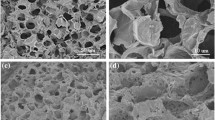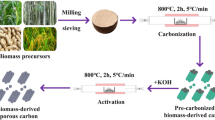Abstract
In this study, we used a two-stage process and phosphoric acid to thermochemically transform waste biomass rice straw into porous carbon (PC) for the preparation of high-performance supercapacitor electrodes. The morphological and chemical characteristics of PC were investigated by X-ray diffraction, scanning electron microscopy, surface area, and porosity analyses by the BET (Brunauer, Emmett, and Teller) nitrogen adsorption method, Fourier transform infrared spectroscopy. The modification process leads to the increase in the specific surface area and pore size of PC. The dc conductivity of the samples determined at room temperature was found to increase from 16.1 × 10−5 to 10.16 × 10−3 Ω−1 cm−1. The samples showed good electrochemical property with specific capacitance possessing in the range of 56–112 F/g. It was found that the carbonization temperature plays a crucial role on the evolution of structural and electrochemical properties of porous carbons. These porous carbons which show a particular large reversible capacity are proved to be promising electrode materials for high-rate and high-performance supercapacitors.









Similar content being viewed by others
References
Gao P, Zhen-hong L, Gang X, Bin H, Mei-hua Z (2011) Preparation and characterization of activated carbon produced from rice straw by (NH4)2HPO4 activation. Bioresour Technol 102:3645–3648
Robinson P (2006) University of California Davis, personal communication
Zhang F, Wang KX, Li GD, Jie-Sheng C (2009) Hierarchical porous carbon derived from rice straw for lithium ion batteries with high-rate performance. Electrochem Commun 11:130–133
Andrew B (2007) R&D considerations for the performance and application of electrochemical Capacitors. Electrochim Acta 53:1083–1091
Pandolfo AG, Hollenkamp AF (2006) Carbon properties and their role in supercapacitors. J Power Sources 157:11–27
Conway BE (1999) Electrochemical Supercapacitors. Kluwer Academic, New York
Marin MO, Fernandez JA, Lazaro MJ, Gonzalez CF, Garcia AM, Serrano VG, Stoeckli F, Centeno TA (2009) Cherry stones as precursor of activated carbons for supercapacitors. J Mater Chem Phys 114:323–327
Thomas ER, Denisa HJ, Kiran K, Zhu Z, Gao QL (2010) Microstructure and electrochemical double-layer capacitance of carbon electrodes prepared by zinc chloride activation of sugarcane bagasse. J Power Sources 195:912–918
Chi-Chang H, Chen-Ching W, Feng CW, Ru-Ling T (2007) Characterization of pistachio shell- derived carbons activated by a combination of KOH and CO2 for electric double-layer capacitors. Electrochim Acta 52:2498–2505
Yong JK, Byong JL, Hiroaki STC, Yusuke A, Takasahi Y, Ki CP, Morinobu E (2006) Preparation and characterization of bamboo-based activated carbons as electrode materials for electric double layer capacitors. Carbon 44:1592–1595
Okamura M, Takeuchi M (2002) US Patent 2002/0012223
Feng CW, Ru LT, Chi-Chang H, Chen CW (2004) Physical and electrochemical characterization of activated carbons prepared from firewoods for supercapacitors. J Power Sources 138:351–359
Fierro V, Fernandez TV, Celzard A (2006) Kraft lignin as a precursor for microporous activated carbons prepared by impregnation with ortho-phosphoric acid: synthesis and textural characterization. Micropor Mesopor Mater 92:243–250
Fierro V, Fernandez TV, Celzard A (2007) Methodical study of the chemical activation of kraft lignin with KOH and NaOH. Micropor Mesopor Mater 101:419–431
Toles CA, Marshall WE, Johns MM, Lynda H, Wartelle LH, McAloon A (2000) Acid- activated carbons from almond shells: physical, chemical and adsorptive properties and estimated cost of production. Biores Technol 71:87–92
Fierro V, Fernandez TV, Celzard A (2005) Study of the decomposition of kraft lignin impregnated with orthophosphoric acid. Thermochim Acta 433:142–148
Montane D, Fernandez TV, Fierro V (2005) Activated carbons from lignin: kinetic modeling of the pyrolysis of Kraft lignin activated with phosphoric acid. J Chem Eng Data 106:1–12
Jagtoyen M, Derbyshire F (1993) Some considerations of the origins of porosity in carbons chemically activated wood. Carbon 31:1185–1192
Gupta VK, Pathania D, Sharma S, Singh P (2013) Preparation of bio-based porous carbon by microwave assisted phosphoric acid activation and its use for adsorption of Cr(VI). J Colloid Interface Sci 401:125–132
Benaddi H, Legras D, Rouzaud JN, Beguin F (1998) Influence of the atmosphere in the chemical activation of wood by phosphoric acid. Carbon 36:306–309
Zhonghua H, Srinivasan MP, Yaming N (2001) Novel activation process for preparing highly microporous and mesoporous activated carbons. Carbon 39:877–886
Salame I, Teresa JB (2000) Comparison of the surface features of two wood-based activated carbons. J Ind Eng Chem Res 39:301–306
Gregg SJ, Sing KSW (1982) Adsorption. Academic Press, London, Surface Area and Porosity
Liao C, Wu C, Yanyongjie Y, Huang H (2004) Chemical elemental characteristics of biomass fuels in China. Biomass Bioenerg 27:119–130
Van Soest PJ (2006) Rice straw, the role of silica and treatments to improve quality. Anim Feed Sci Tech 130:137–171
Raveendran K, Anuraddha G, Kartic C, Khilar K (1995) Influence of mineral matter on biomass pyrolysis characteristics. Fuel 74:1812–1822
Chang HY, Yun HP, Chong RP (2001) Effects of pre-carbonization on porosity development of activated carbons from rice straw. Carbon 39:559–567
Solum MS, Pugmine RJ, Jagyoten M (1995) Evolution of carbon structure in chemically activated wood. Carbon 33:1247–1254
Kennedy LJ, Vijaya JJ, Sekaran G (2004) Effect of two-stage process on the preparation and characterization of porous carbon composite from rice husk by phosphoric acid activation. J Ind Eng Chem Res 43:1832–1838
Serge B, Le Michel B, Rene D (1995) Carbonization mechanisms resulting from intumescence- part II. Association with an ethylene terpolymer and the ammonium polyphosphate-pentaerythritol fire retardant system. Carbon 33:283–294
Tzong HL (2004) Preparation and characterization of nano-structured silica from rice husk. Mater Sci Eng A 364:313–323
Gyu H, Chong RP (2002) Preparation and characteristics of rice-straw based porous carbons with high adsorption capacity. Fuel 813:327–336
Zhu Z, Hu Y, Jiang H, Chunzhong Li (2014) A three-dimensional ordered mesoporous carbon/carbon nanotubes nanocomposites for supercapacitor. J Power Sources 246:402–408
Guo Y, Yang S, Wang Z (2002) The preparation and mechanism studies of rice husk based porous carbon. Mater Chem Phys 74:320–324
Fierro V, Muñiz G, Basta AH, El-Saied H, Celzard A (2010) Rice straw as precursor of activated carbons: activation with ortho-phosphoric acid. J Hazard Mater 181:27–30
Jeong E, Jung MJ, Lee YK (2013) Role of fluorination in improvement of the electrochemical properties of activated carbon nanofiber electrodes. J Fluorine Chem 50:98–103
Dana P, Hans D, Serge K, Lydia S, Christian R (2001) Electrical conductivity of thermal carbon blacks: influence of surface chemistry. Carbon 39:1147–1158
Rhoderick EH, Williams RH (1998) Metal-semiconductor contacts, 2nd edn. Oxford University Press, New York
Kaus M, Kowal J, Sauer DU (2010) Modelling the effects of charge redistribution during self-discharge of supercapacitors. Electrochim Acta 55:7516–7523
Subramanian V, Luo C, Stephan AM, Nahm KS, Thomas S, Wei B (2007) Supercapacitors from activated carbon derived from banana fibers. J Phys Chem C 111:7527–7532
Chun-Hisen H, Ruey-An HD (2012) Sugarcane bagasse as the scaffold for mass production of hierarchically porous carbon monoliths by surface self-assembly. Micro Meso Mater 147:47–52
Putun AE, Ozbay N, Onal EP, Putun E (2005) Fixed-bed pyrolysis of cotton stalk for liquid and solid products. Fuel Process Technol 86:1207–1219
Wigman T (1989) Industrial aspects of production and use of activated carbons. Carbon 27:13–22
Acknowledgments
The corresponding author duly acknowledge the financial support rendered by SERC Division, Department of Science and Technology (DST), New Delhi, India, through the young scientist project scheme vide reference no. SR/FTP/PS-76/2005.
Author information
Authors and Affiliations
Corresponding author
Rights and permissions
About this article
Cite this article
Adinaveen, T., John Kennedy, L., Judith Vijaya, J. et al. Surface and porous characterization of activated carbon prepared from pyrolysis of biomass (rice straw) by two-stage procedure and its applications in supercapacitor electrodes. J Mater Cycles Waste Manag 17, 736–747 (2015). https://doi.org/10.1007/s10163-014-0302-6
Received:
Accepted:
Published:
Issue Date:
DOI: https://doi.org/10.1007/s10163-014-0302-6




